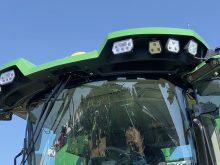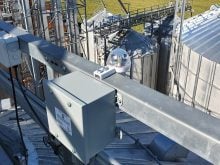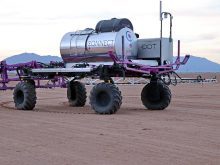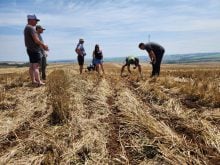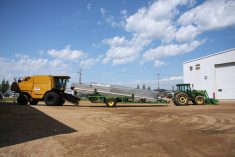Until now, the cost of setting up a survey-grade RTK network was $30 to $50 per section of land.
A new Alberta company is dropping that cost to $2 to $3 per section.
For $2,000, producers can add a digital cellular modem to their existing GPS and receive survey-grade RTK along with interactive high-speed internet in their cab.
The new system has been developed by Ranchview Inc. of Red Deer and is expected to be available to prairie farmers by next spring. A few areas already have the service.
Read Also
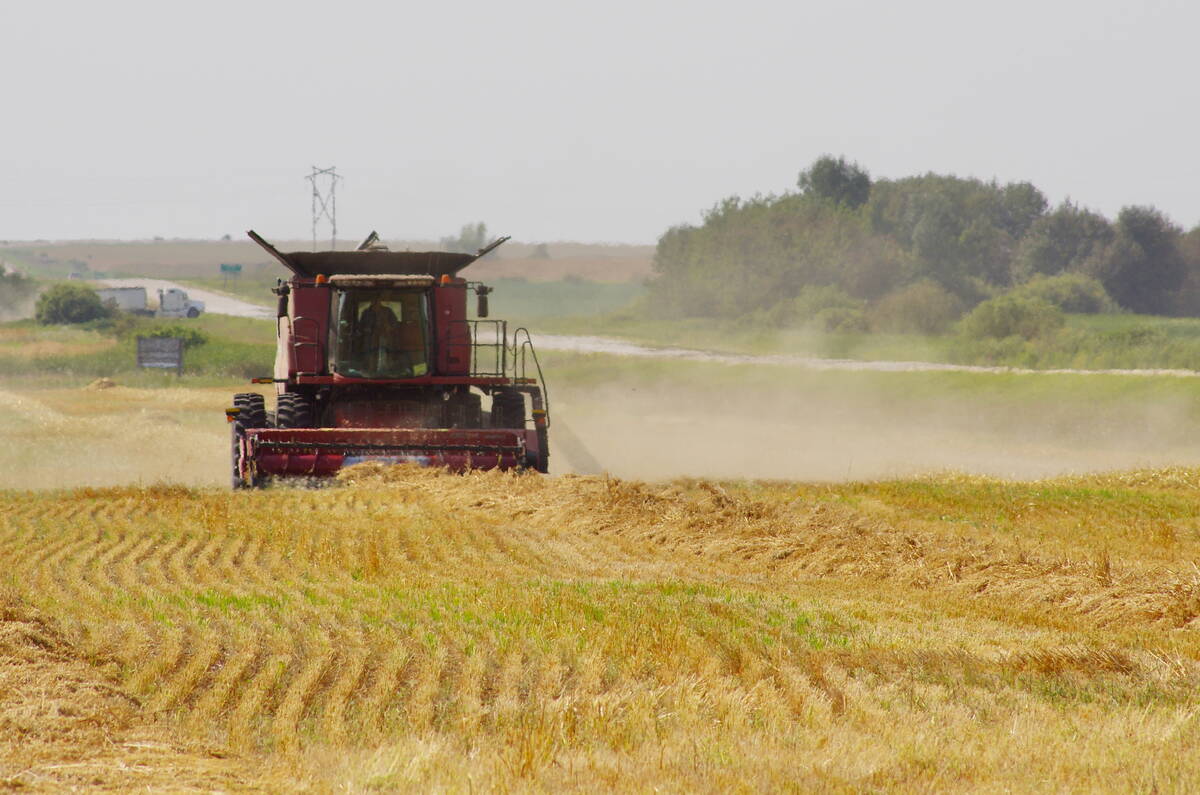
Herbicide resistance sprouts in Manitoba’s wild oats
Farmers across Manitoba this fall are gearing up for the latest salvo in what, for many, has become a longtime battle to beat out wild oats.
Customers will also pay an annual $1,500 subscription fee.
Building their own RTK tower would cost producers $20,000 to $40,000.
“Take a point on a map that represents a base station and draw a 50 mile (80 kilometre) radius around it,” said Ranchview president and chief engineer Clint Mundt.
“There’s five million acres of land in that circle. And there are cell towers all across the Prairies. That’s what brings the price down.”
Although RTK, together with high-speed internet in the cab, is a breakthrough in agriculture, Ranchview sales vice-president Kirk Appleford said it’s really a matter of pulling together a number of proven technologies.
Some of these durable units have been used in Alberta oil fields for the past decade, he added.
To understand how the system works, Appleford said it’s necessary to abandon previous notions about how RTK GPS signals reach the cab.
“This is totally different from the standalone systems we’re used to seeing, with a differential correction tower at the edge of your field. That’s obsolete technology,” he said.
“The traditional RTK differential correction tower is strictly line of sight. You lose the signal when you go over a hill, down into a low spot or behind some trees or grain bins.
“With Ranchview, the correction signals are transmitted to you through the digital cellular network towers. If there is cellular service available at your field, we can give you survey grade RTK. And the accuracy is repeatable year after year.”
The Ranchview modem does not replace a farmer’s existing GPS system. Rather, it adds RTK differential correction to the current GPS, but at a lower cost than other systems on the market.
Appleford said the satellite signals pass through Ranchview dealerships, which can be implement dealers, grain elevators, fertilizer dealers or certified crop advisers.
“There’s no need for a dealer to build a tower or incur a large infrastructure cost. The main requirement is that a dealer must be highly knowledgeable in GPS guidance and field mapping.”
The dealer sells modems and subscription to farmers, while Ranchview works only with the dealers.
Once the hardware is hooked up, the dealer is capable of providing RTK and high speed internet to clients within an 80 km radius.
Appleford plugs Ranchview’s base station equipment into the dealers’ existing high-speed internet. Up on the roof, he installs a GPS domed antenna, similar to what is installed on tractor cabs. Like any GPS receiver, it needs an unobstructed view of the sky.
Signals from the roof-mounted receiver go to the base station in the dealer’s building. It generates the corrections, which are then sent to Ranchview’s servers via high-speed internet.
“We then transmit the corrected signals out to the clients through the existing cellular network,” Appleford said.
Performance in the field depends on the age and quality of the farm implement’s GPS equipment. Mundt said new generations of GPS have better RTK capabilities.
“With some of the latest Trimble products, we’ve had good accuracy and good results 75 and 80 miles (120 and 130 km) from the dealer.”
Mundt said there can be a discrepancy of as much as four inches if a client is at the edge of the recommended limit of 80 km. That much error occurs only in the rare time when atmospheric conditions over the dealer base station are considerably different than the weather over the implement 80 km away.
If a dealer had a lot of customers with high accuracy demands, such as row croppers, Mundt said it would be possible for that dealer to set up as many base stations as required.
The modem that customers buy is just one piece of the hardware that plugs into the GPS head on the implement. The kit also includes two high gain antennas for the cab roof, coaxial cable and power cord.
To receive these exact location instructions, the existing GPS receiver must be capable of supporting RTK corrections. Units can be upgraded by a Ranchview dealer.
Mundt said wireless carriers in Western Canada have done an excellent job of blanketing the region with cellphone coverage.
The overall Ranchview strategy depends on using those cellular networks, a strategy far more efficient than setting up a new network of towers and transmitters.
The system is compatible with all cellular providers.
“The customer needs a wireless plan on their modem in order to receive the Ranchview RTK corrections,” Mundt said.
“The local dealer works with the wireless carriers to ensure the customer obtains the right wireless plan.”
Farmers won’t be able to use Ranchview’s service if their area doesn’t have digital cellular signal, but Appleford said the system still functions if there is a weak, sketchy cell phone signal.
“We can make a weak signal 10 or 12 times stronger. That’s enough to give you good RTK,” he said.
“We use dual high gain antennas on the cab roof. The other factor is that the modems we put in your cab are industrial grade, military spec. It’s the same modems they use in the gas and oil industry, in tracking cargo shipments, all kinds of industrial uses.”
Appleford said an added benefit is the modems have built-in systems to automatically monitor performance of the equipment in the field.
The equipment is engineered for troubleshooting and diagnostics and to automatically report back to the server. There’s no need for the farmer to identify and report the problem.
Ranchview communicates a universal, industry standard correction signal to all GPS equipment capable of accepting it. However, some companies still maintain a proprietary code that excludes Ranchview.
“We think these other systems are capable of accepting our signal. It’s a matter of whether or not those companies are willing to expose it to their customers,” Mundt said.
The modem installed in the implement cab is equipped with a port for high-speed internet service, which gives operators access to real time information that was previously available only back at the office.
“This is where the next generation of agricultural equipment is headed – full internet service in the cab,” Appleford said.
Many field computers are built with an ethernet port for high-speed internet, a feature some farmers have already asked for.
“Here’s an example. Agri-Trend provides all their clients with laptops. An Agri-Trend client with Ranchview can take his tablet into the cab, plug into our modem and go on-line directly to their agri-coach.
“You can download prescription maps, send your agronomist field data, get real time weather reports, commodity prices, parts and service manuals or anything else you need in the field.”
Mundt said this doesn’t mean farmers can watch CFL football or the Discovery Channel.
“Our target is agriculture. There’s only a limited amount of network band width available, so we don’t want to use it up in a frivolous way,” he said.
“If there’s too much demand, you’ll slow down your corrections, and that’s what you need this for in the first place – corrections.”
Ranchview has about a dozen Ranchview sites on the Prairies. By next spring it expects to have enough dealers to provide service to most areas that have digital cellular service.
For more information, e-mail kirk@ranchview.ca or clint@ranchview.ca or visit www.ranchview.ca.





